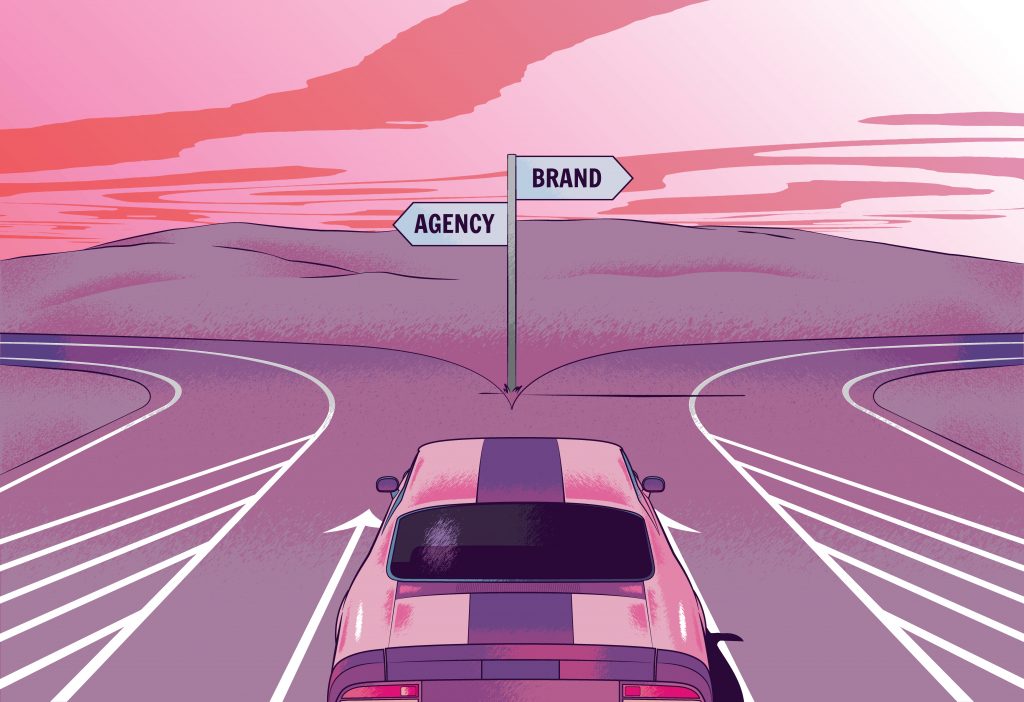Starting out in the creative industries, you dream of the busy agency life. You envisage being surrounded with like-minded peers, led by quirky and ferociously inspiring creative directors in a vibrant city quarter. More London’s buzzing Clerkenwell than Schiphol’s corporate business center.

In 2011, I was cutting my teeth in Clerkenwell at Design Bridge, working with an array of multinational clients. Today, I find myself in Schiphol at RB’s HQ, a multinational FMCG organisation with a vast suite of household brands. The journey from one to the other has been fascinating and ultimately hugely rewarding. It may not be for all, but it should be ‘under consideration’ for most. And here is why…
Reimagining the hero
I had always been intrigued by idea of going client-side. My plan was to work my way up to a client leadership position in-agency and then hop across to learn more about the trials and tribulations of the client world.
At an agency, there is a definite and wonderfully confident feeling that whatever the challenge, the agency can add value. The stance at the agencies I worked at – which absolutely fed that confidence – was one of the ‘hero’. Every client meeting had the sub-text of “How can I be your hero today?”. Moving client-side was a definite culture shock. The attitude shifted from a “What if?” mindset to a “So what?” attitude. It was a sudden shift in the types of conversations you would have with colleagues from expansive ideation to reductive targeting.
But the hero aspect remained, if in an entirely different guise. Rather than asking “How I can be your hero?”, the question – and the art – is in defining exactly how you (the agency) can be my (the client’s) hero. The role morphs from realising the potential of a brief, to creating that potential in the first place.
Creativity client-side is also a very different thing to creativity agency-side. It is unarguable that creative agencies attract more creative talent. But where creativity really comes into play in-house is in the pitch for the agency’s attention. As a client, it is your responsibility to create a brief that sparks the right thoughts for the creative team, and then manage and protect a safe space for the idea to flourish. All too often the idea gets watered down after the initial presentation. As a client, you need to get very creative in how you protect the core idea when circulating it within the business and managing the different angles and perspectives from across the business.
From executor to curator
Therein lies the challenge and thrill of moving client-side. Your ability to manage and curate the way a brand comes to life for the people it is there to serve is vastly increased. With that comes a great and more complete – but a longer to realise – level of satisfaction.
Some seem to think that moving client-side is the more sedate, sedentary, dare I say ‘boring’ alternative to agency life. But nothing could be further from the truth. RB, for example, is a business that is constantly refining itself. There has never been a year in which the operating model has stood still. When coming into a business like this, do not expect to sit comfortably in a process. This is a business that values tenacity and ownership. And it will test you. It will make you grow, as the business itself is growing.
What coming in-house has definitely taught me is humility and that there is no single hero in the process of bringing a product to market. It is a vast system of interconnected elements that need to come together like clockwork.
When that does comes together and you have the chance to see something that you have nurtured from a seedling of an idea come to fruition, and you feel the weight of the business fall in line behind the progress of your idea, it is something quite special.
A growing demand for creative talent
Brand owners are certainly open to bringing good agency-side talent on board. According to a report by executive search firm Grace Blue, almost 40% of senior-level marketing talent has a background agency-side, up from nearer 25% a few years ago.
In the FMCG sector, the focus on delivering a total brand experience is growing, driven by what people expect from the brands they invite into their lives. This means that the typical FMCG model is being readdressed. The unique value that good creative talent provides is the ability to connect the different dots in delivering the total experience – to link across the traditional silos of marketing, insights, packaging and R&D.

Opportunities of working on the client-side are certainly growing. But if you are thinking of making the move across the tracks, I suggest learning to lead a team in an agency environment first. Learn to bring the best out of people across different types of challenges and secure yourself and your point of view on the world around you. Once you have defined yourself, tackling the client world is a great next step.
By James Lancaster – Brand Experience Lead, Lysol, RB

You must be logged in to post a comment Login